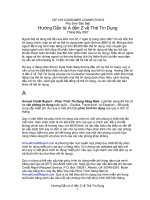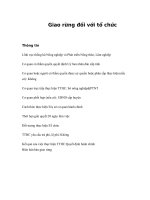Tài liệu Application of own credit risk adjustments to derivatives ppt
Bạn đang xem bản rút gọn của tài liệu. Xem và tải ngay bản đầy đủ của tài liệu tại đây (128.88 KB, 12 trang )
Basel Committee
on Banking Supervision
Consultative Document
Application of own credit
risk adjustments to
derivatives
Issued for comment by 17 February 2012
December 2011
This publication is available on the BIS website (www.bis.org
).
© Bank for International Settlements 2011. All rights reserved. Brief excerpts may be reproduced or
translated provided the source is cited.
ISBN 92-9131-079-4 (print)
ISBN 92-9197-079-4 (online)
Derecognition of derivatives valuation adjustments due to own credit-risk
Contents
Application of own credit risk adjustments to derivatives 1
Executive Summary 1
Background 1
Issue for derivatives 2
Proposed approach: Full deduction of DVA 3
Annex: Alternative approaches considered 4
(a) Recognition of initial DVA assuming a linear decay 4
(b) Derecognition of DVA changes due to the bank’s own creditworthiness 4
(c) Adjustment based on liquidation claim and balance sheet value 5
Derecognition of derivatives valuation adjustments due to own credit risk
1
Application of own credit risk adjustments to derivatives
The Basel Committee welcomes comments on all aspects of this consultative document by
Friday 17 February 2012. Comments should be sent by e-mail to
Alternatively, comments may be addressed to
the following address: Basel Committee on
Banking Supervision, Bank for International Settlements, Centralbahnplatz 2, CH-4002
Basel, Switzerland. All comments may be published on the BIS website unless a commenter
specifically requests confidential treatment.
Executive Summary
Paragraph 75 of the Basel III rules text requires banks to “[d]erecognise in the calculation of
Common Equity Tier 1, all unrealised gains and losses that have resulted from changes in
the fair value of liabilities that are due to changes in the bank’s own credit risk.”
1
This rule
ensures that an increase in credit risk of a bank does not lead to a reduction in the value of
its liabilities, and thereby an increase in its common equity.
This overarching principle applies to debt issued by banks and also has implications for the
treatment of fair valued derivatives. However, the application of paragraph 75 to derivatives
is not straightforward since their valuations depend on a range of factors other than the
bank’s own creditworthiness,
2
such as interest rates and other market factors that can affect
the exposures value. It is not easy to separate out changes in value that are only due to
changes in a bank’s own credit risk.
This consultative paper includes a brief discussion of various options that the Basel
Committee has considered to apply the underlying concept of paragraph 75 to over-the-
counter (OTC) derivatives (and securities financing transactions (SFTs)
3
). It proposes that
debit valuation adjustments (DVAs) for these products should be fully deducted in the
calculation of Common Equity Tier 1 (CET1).
Background
The Basel Committee published in June 2004 a press release titled “Regulatory capital in
light of forthcoming changes in accounting standards”.
4
It stated that “the Committee …
examined the appropriate regulatory treatment of any gains and losses arising from changes
in an institution’s own credit risk as a result of applying the fair value option to its liabilities.
1
Paragraph 75 of “Basel III: A global regulatory framework for more resilient banks and banking systems”
(published in December 2010 and revised in June 2011), available at www.bis.org/publ/bcbs189.pdf.
2
The bank’s creditworthiness can be measured on the basis of credit risk parameters such as credit spreads
and default probabilities.
3
While it is quite common for internationally active banks to do own-credit related adjustments to the
accounting value of derivatives, this is much less common for SFTs. For this reason, the present paper will
only mention derivatives. However, if a bank takes its own creditworthiness into account in the accounting
value of SFTs, it will be required to apply the same CET1 adjustments as required for derivatives.
4
Available at: www.bis.org/press/p040608.htm
2
Derecognition of derivatives valuation adjustments due to own credit risk
The Committee believes that the potential inclusion of these gains and losses … raises
significant supervisory concerns and is of the view that they should be excluded.”
The ‘Supervisory guidance on the use of the fair value option by banks under IFRS’,
published in June 2006 by the Basel Committee, also indicated in principle 7 that “regulatory
capital should be adjusted for gains and losses from changes in own credit risk as a result of
applying the fair value option to financial liabilities.” This adjustment avoids an increase in a
bank’s capital when its own creditworthiness deteriorates, which would otherwise undermine
the quality of capital and the protection it provides to depositors and senior creditors.
Paragraph 75 of Basel III applies this approach to all fair-valued liabilities.
Issue for derivatives
The fair-value pricing of an OTC derivative depends on market variables (ie interest rates,
exchange rates, etc) and the creditworthiness of both banks entering into the contract, as
well as the valuation methodologies used by banks. In this context, a credit valuation
adjustment (CVA) is typically defined as the difference between the value of a derivative
assumming the counterparty is default-risk free and the value reflecting default risk of the
counterparty. Similarly, a debit valuation adjustment (DVA) is typically defined as the
difference between the value of the derivative assuming the bank is default-risk free and the
value reflecting default risk of the bank.
5
Changes in a bank’s own credit risk therefore result
in changes in the DVA component of the valuation of the bank’s derivatives.
Compared to non-derivative liabilities, there are several complications associated with
isolating changes in the fair value of derviatives due to changes in a bank’s own
creditworthiness, inlcuding:
DVAs depend on the bank’s own creditworthiness, the interest rate used for
discounting and other drivers of the expected exposure that the derivative creates
for the counterparty. Therefore, DVAs are sensitive not only to changes in the own
creditworthiness (ie credit spreads or probabilities of default) but also to changes in
all factors that affect the expected exposures.
When close-out netting applies to a set of derivative contracts, the computation of
DVAs must take into account the netting set because the expected exposure
becomes a portfolio measure rather than a single-trade measure.
DVAs exist irrespective of whether the current fair value of a trade or a netting set of
trades is positive (representing a net asset) or negative (representing a net liability).
At the inception of new un-netted trades, a positive DVA exists from the very
beginning. When new trades enter existing netting sets, this has an immediate
impact on the DVA of that netting set. The impact is typically positive but can be
negative in some cases.
The estimation of DVAs requires complex modeling methodologies that estimate the
evolution of exposures over time and rely on assumptions and parameters that can
vary from bank to bank.
5
That is: DVA = fair value (reflecting all counterparty credit risk) – hypothetical fair value ignoring own credit
risk.
Derecognition of derivatives valuation adjustments due to own credit risk
3
Given the complexities above, banks have questioned the way in which the treatment of own
credit risk set out in paragraph 75 of Basel III should be applied to derivatives contracts. This
consultative document seeks views on a proposal for a common approach that banks would
be required to follow.
Proposed approach: Full deduction of DVA
The adjustment required by paragraph 75 of Basel III neutralises the impact of changes in a
bank’s own credit risk in the calculation of CET1. It does not derecognise all own credit risk
at inception.
6
The Basel Committee considered various ways that banks could be required to apply
paragraph 75 such that the impact of changes in own credit risk on the fair value of
derviatives will be neutralised (see the annex). However, the options considered are viewed
as either too complex, lacking conservatism, or relying too heavily on modelling assumptions.
Therefore, after considering various alternatives, the Basel Committee is of the view that all
DVAs for derivatives should be fully deducted in the calculation of CET1. The deduction of
DVAs is to occur at each reporting date, and requires deducting the spread premium over the
risk free rate for derivative liabilities. In effect, this would require banks to value their
derivatives for CET1 purposes as if they (but not their counterparties) were risk free, and
deduct the unrealised gains both at inception of the derivative and afterwards, when the
creditworthiness of the bank deteriorates.
The Basel Committee recognises that this option is generally more conservative than
paragraph 75, as it generally leads to a CET1 deduction at trade inception equal to the credit
risk premium of the bank, rather than the change in value of derivative contracts occuring as
a result of changes in the reporting bank’s own credit risk.
However, the option is transparent and simple when compared to the alternatives set out in
the annex, and ensures that a deterioration in own credit risk cannot result in a CET1
increase.
6
For example, when a bank issues a bond at par value, the bank is actually valuing the bond using a discount
rate that reflects its own credit risk at the moment of issuance and investors will receive coupon payments that
factor in that level of credit risk. There will be no adjustment required by paragraph 75 at inception in respect
of this bond; only subsequent changes in the credit standing of the bank will lead to an adjustment.
4
Derecognition of derivatives valuation adjustments due to own credit risk
Annex
Alternative approaches considered
This annex provides an overview of the alternative options that the Basel Committee
considered. These options are viewed as too complex, lacking conservatism or relying too
heavily on modelling assumptions.
(a) Recognition of initial DVA assuming a linear decay
In an attempt to de-recognise only changes in DVA, but not initial DVA, the Basel Committee
considered an option where the initial DVA of new trades would be fully recognised in CET1.
The option considered was to assume a pattern of DVA as trades appraoch maturity. More
specifically, the maturing of existing trades would be approximated by a linear decay of the
initial DVA. All other sources of DVA changes (not restricted to changes in own
creditworthiness, but also changes in potential future exposure and interest rates) would be
derecognised.
At inception of each new trade, banks would have to calculate the DVA impact of adding this
trade to the existing netting set. This impact is called the “initial DVA” of that trade. If the
trade is not netted, this simply corresponds to the DVA at inception. “Initial DVA” could be
negative in some cases, when a new trade reduces the counterparty’s exposure to the bank
in an existing netting set.
For each netting-set, the “regulatory DVA” for the purpose of CET1 determination would be
calculated as the greater of zero and the sum over all trades of their initial DVA multiplied by
the remaining time to maturity divided by the initial time to maturity. In the calculation of
CET1, all derivative DVAs would be replaced by the regulatory DVA. That is, as a correction
to CET1, banks would subtract accounting DVA and add the regulatory DVA.
This option is not suported by the Basel Committee because of its complexity and the
introduction of a new concept (ie the “regulatory DVA”). Furthermore, the linear decay may
not be in all cases a realistic or conservative approximation of how DVAs of existing trades
would evolve if all market factors remained constant since inception.
(b) Derecognition of DVA changes due to the bank’s own
creditworthiness
The Basel Committee also considered an option that attempts to replicate as close as
possible the treatment for non-derivative liabilities. Under this option, the aim would be to
derecognise gains and losses due to changes in the bank’s own creditworthiness, but
recognise all other effects related to DVA.
Derecognition of derivatives valuation adjustments due to own credit risk
5
For a derivative that is not netted, the bank would also have to calculate the DVA based on
the bank’s historical creditworthiness
7
as of the derivative’s inception date. Otherwise,
current market prices (interest rates, exchange rates, etc) are used as for the accounting
DVA. This defines the “regulatory DVA”. In the calculation of CET1, all derivative DVAs
would be replaced by the regulatory DVA. That is, as a correction to CET1, banks would
subtract accounting DVA and add the regulatory DVA.
For netting sets that contain derivative contracts with different inception dates, the netting set
DVA would have to be allocated to the individual trades using an appropriate allocation
model yet to be defined. In analogy to the DVAs of non-netted trades, these allocated trade-
level DVAs would have to be calculated twice using, the banks actual and historical
creditworthiness respectively, and the CET1 would be corrected by the difference between
the two outcomes.
This option is not supported by the Basel Committee because of its complexity and the
introduction of new regulatory concepts (ie trade level DVA allocation, and DVAs based on
the bank’s historical creditworthiness). Also, the precise outcome of this approach would
depend on the details of the allocation model, yet to be defined.
(c) Adjustment based on liquidation claim and balance sheet value
The Basel Committee also considered an option that would require banks to look at each
derivative and deduct in the calculation of CET1 any decrease in common equity that would
occur if the derivative was revalued to reflect the claim of the bank or counterparty on the
insolvency of the bank. If the claim on the insolvency of the bank is uncertain, the bank would
be required to calculate the maximum claim that could be made in respect of the derivative.
The method used to determine the claim would need to be applied consistently between
derivative assets and derivative liabilities.
The aim of this approach is to only require an adjustment in the calculation of CET1 where
this is necessary to ensure that CET1 reflects the protection available to depositors and other
senior creditors on the failure of the bank.
Before considering how this approach would apply to derivatives, it is useful to consider the
simpler case of non-derivative liabilities. For example, consider a bank that issues a bond
with an initial fair value of 100 and a claim on insolvency of 100, and assume that this bond is
fair valued on the balance sheet. If the own credit risk of the bank deteriorates the bond
liability decreases. Let us assume that it decreases from 100 to 95. This creates 5 of
common equity on the balance sheet. However, it would not be appropriate to rely on this
additional 5 of common equity because if the bank fails, the claim of the bondholder is 100,
not 95. This means that the 5 of common equity that was generated disappears in
insolvency. In other words the 5 of common equity is not loss absorbent. Paragraph 75 of the
Basel III requires this bank to deduct 5 from common equity in the calculation of CET1.
Similar logic can be applied to determine the appropriate prudential adjustment for
derivatives. For example, consider a bank that takes out a swap with a counterparty of equal
credit standing and that the swap has zero value on inception. Then assume that the credit
standing of the bank deteriorates. This deterioration leads to an increase of DVA. Let us
7
In practice, this would be historical credit spread curves in most cases.
6
Derecognition of derivatives valuation adjustments due to own credit risk
assume that in this case a DVA increase of 5 is created. The creation of this additional DVA
on the balance sheet leads in turn to the creation of common equity of 5. However, if the
bank fails, the claim of the counterparty will likely be zero. In other words the 5 of common
equity that was created by the DVA asset is not loss absorbent. The appropriate prudential
treatment therefore seems to be to deduct 5 from common equity in the calculation of CET1.
This is the treatment that would be required by approach (c).
8
The bank would be required to look at the current value of the derivative on the balance
sheet (5 in the example above) and the claim of its counterparty in insolvency (zero in the
example above) and deducts the positive difference from common equity (to reflect the fact
that the valuation of the derivative asset changes from 5 to zero in insolvency).
This option is not supported by the Basel Committee given concerns that banks are often not
in a position to determine accurately the close-out value of derivatives.
8
Please note that the alternatives (a) and (b) and (c) would all lead to the same outcome in this simple example
but they would differ in more realistic cases.









